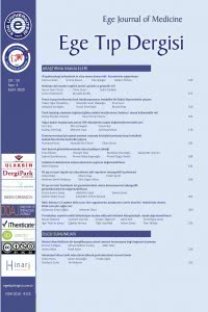The beta-lactamase activities and the resistance patterns of Klebsiella species to antimicrobial agents
- ISSN: 1017-7698
- Yayın Aralığı: 3
- Başlangıç: 2018
- Yayıncı: Ege Üniv. Tıp Fak.
$T_1$ glottic carcinoma: Results with radiotherapy and salvage surgery
Ahmet Ömer İKİZ, Fadime AKMAN, Enis Alpin GÜNERİ, Mehmet ŞEN, Ertap AKOĞLU, Münir KINAY, Kerim CERYAN
Effects of pre-and post-treatment of nicotine on active avoidance learning
ÖZLEM YILMAZ, LÜTFİYE KANIT, Berrin E. OKUR, Şakire PÖĞÜN
Mine ERDENİZMENLİ, Onur ÖZGENÇ, Ayten URBARLI
Hypothyroid hypertrophic cardiomyopathy
Filiz ÖZERKAN, Meral KAYIKÇIOĞLU, Mehdi ZOGHİ, Cemil GÜRGÜN, İstemi NALBANTGİL
MR angiography of abnormal vascular structures in rolandic cortical dysplasia
İlginç YORULMAZ, Süheyla DURMAZ, Cem M. ÇALLI, Işıl BİLGEN, R. Nuri ŞENER
Correlation of thyroid histopathology with fine needle aspiration of thyroid nodules
Hasan ÜSTÜN, Özkal Melek ÜSTÜN, Mustafa Kemal BALCI, Nadir PAKSOY, Hasan ALTUNBAŞ, Ümit KARAYALÇIN
The influence of age on cerebrospinal fluıd endorphin levels
The surgical treatment of left ventricle aneurysm; patch repair versus conventional closure
Belhhan AKPINAR, İLHAN SANİSOĞLU, Osman BAYINDIR, Saide AYTEKİN, Vedat AYTEKİN, Bingür SÖNMEZ, Cemi DEMİROĞLU
Treatment results in laryngotracheal stenosis
Enis Alpin GÜNERİ, Semih SÜTAY, Ahmet Ömer İKİZ
Benign fibrous mesothelioma ( Case report )
Pınar ÇELİK, Arzu YORGANCIOĞLU, UFUK ÇAĞIRICI, Ali VERAL, İlginç YORULMAZ
